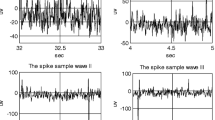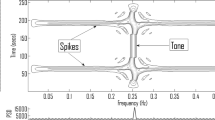Abstract
This correspondence presents a technique for the electroencephalogram (EEG) spike enhancement and detection, which uses the Kalman filtering (KF) approach based on the output correlation method for the nonstationary signal enhancement. We describe the nonstationary EEG signal in terms of the general Markov model, in which the parameters are considered to be time-varying. In the proposed methodology, neither the process and measurement noise statistics nor the initial Kalman blending factor are stringently required. The EEG epileptic spikes (ESs) are pre-emphasized using the output correlation method, and subsequently, the detection is performed using the decision threshold based on the output of same adaptive filter. We have tested the proposed scheme on the synthetic EEG signal corrupted with randomly occurring triangular spikes. The presented simulation results manifest significant improvement in the signal-to-noise ratio (SNR) due to the modified estimation of time-varying parameters of the general Markov model, which in turn leads to the alleviated number of false-positives (FPs). It is apparent that the real-time EEG signal (rat data) can be analyzed using the proposed EEG epileptic spike enhancement and detection adaptive scheme, which outperforms the conventional KF technique under the different SNR conditions. At 10 dB SNR, the output correlation method provides approximately 40 % reduction in FPs for the triangular spikes in synthetic EEG signal and approximately 27.5 % reduction in FPs for ESs in the rat data as compared to the conventional KF scheme.







Similar content being viewed by others
References
N. Acir, I. Oztura, M. Kuntalp, B. Balkan, C. Guzelis, Automatic detection of epileptiform events in EEG by a three-stage procedure based on artificial neural networks. IEEE Trans. Biomed. Eng. 52(1), 30–40 (2005)
M. Arnold, W.H.R. Miltner, H. Witte, R. Bauer, C. Braun, AR adaptive modeling of nonstationary time series by means of Kalman filtering. IEEE Trans. Biomed. Eng. v 45(5), 553–562 (1998)
S. Aydin, Comparison of power spectrum predictors in computing coherence functions for intracortical EEG signals. Ann. Biomed. Eng. 37(1), 192–200 (2009)
G. Bodenstein, H.M. Praetorious, Feature extraction from the electroencephalogram by adaptive segmentation. Proc. IEEE 65(5), 642–652 (1977)
S. Dandapat, G.C. Ray, Spike detection in biomedical signal using mid-prediction filter. IEEE Trans. Sign. Process. 42(9), 2276–2279 (1994)
P.J. Durka, Adaptive time-frequency parameterization of epileptic spikes. Phys. Rev. E 69, 051914 (2004)
T.P. Exarchos, A.T. Tzallas, D.I. Fotiadis, S. Konitsiotis, S. Giannopoulos, EEG transient event detection and classification using association rules. IEEE Trans. Inf. Technol. Biomed. 10(3), 451–457 (2006)
G.M. Friesen, T.C. Jannett, M.A. Jadallah, S.L. Yates, S.R. Quint, H.T. Nagle, A comparison of noise sensitivity of nine QRS detection algorithms. IEEE Trans. Biomed. Eng. 37(1), 85–98 (1990)
J.D. Frost, P. Kellaway, R.A. Harachovy, D.G. Glaze, E.M. Mizrahi, Changes in epileptic configuration associated with attainment of seizure control. Ann. Neurol. 20(6), 723–726 (1986)
H. Garg, A.K. Kohli, Nonstationary-epileptic-spike detection algorithm in EEG signal using SNEOs. Biomed. Eng. Lett. 3(2), 80–86 (2013)
D. Godard, Channel equalization using a Kalman filter for fast data transmission. IBM J. Res. Dev. 18(3), 267–273 (1974)
M.S. Grewal, A.P. Andrew, Kalman Filtering: Theory and Practice (Prentice-Hall, Englewood Cliffs, 1993)
M.S. Grewal, A.P. Andrews, Kalman Filtering Theory and Practice Using MATLAB, 3rd edn. (Wiley, New York, 2008)
A.C. Guyton, Text Book of Medical Physiology (Saunders, Philadelphia, 1986)
H. Hassanpour, M. Mesbah, B. Boashash, EEG spike detection using time-frequency signal analysis. in Proceedings of the IEEE International Conference on Acoustics, Speech and Signal (2004), vol. 5, pp. 421–424
C. James, M. Hagan, R. Jones, P. Bones, G. Carroll, Multireference adaptive noise canceling applied to the EEG. IEEE Trans. Biomed. Eng. 44(8), 775–779 (1997)
S.M. Kay, Fundamentals of Statistical Signal Processing Estimation Theory (Prentice-Hall, Englewood Cliffs, 1993)
K.H. Kim, S.J. Kim, Neural spike sorting under nearly 0-dB signal-to-noise ratio using nonlinear energy operator and artificial neural network classifier. IEEE Trans. Biomed. Eng. 47(10), 1406–1411 (2000)
M.B. Malarvili, H. Hassanpour, M. Mesbah, B. Boashash, A histogram-based electroencephalogram spike detection. in Proceedings of 8th International Symposium on Signal Processing & Its Applications (2005), pp. 207–210
R.K. Mehra, On the identification of variances and adaptive Kalman filtering. IEEE Trans. Autom. Control. AC–15(2), 175–184 (1970)
R.K. Mehra, On-line identification of linear dynamic systems with applications to Kalman filtering. IEEE Trans. Autom. Control. AC–16(1), 12–21 (1971)
R.K. Mehra, Approaches to adaptive filtering. IEEE Trans. Autom. Control. 17(5), 693–698 (1972)
S. Mukhopadhyay, G.C. Ray, A new interpretation of nonlinear energy operator and its efficacy in spike detection. IEEE Trans. Biomed. Eng. 45(2), 1406–1411 (2000)
E. Niedermeyer, F.D. Silva, Electroencephalography: Basic Principals, Clinical Applications and Related Fields (Williams and Wilkins, Baltimore, 1999)
V.P. Oikonomou, A.T. Tzallas, D.I. Fotiadis, A Kalman filter based methodology for EEG spike enhancement. Comput. Methods Programs Biomed. 85(2), 101–108 (2007)
C.C.C. Pang, A. Upton, C. Shine, M. Kamath, A comparison of algorithms for detection of spikes in the electroencephalogram. IEEE Trans. Biomed. Eng. 50(4), 521–525 (2003)
A. Papoulis, Probab. Random Var. Stoch. Process. (McGraw-Hill, New York, 1984)
V. Parsa, P. Parker, Multireference adaptive noise cancellation applied to somatosensory evoked potentials. IEEE Trans. Biomed. Eng. 41(8), 792–800 (1994)
W.D. Penny, S.J. Roberts, Dynamic models for nonstationary signal segmentation. Comput. Biomed. Res. 32(6), 483–502 (1999)
R.Q. Quiroga, A. Kraskov, T. Kreuz, P. Grassberger, Performance of different synchronization measures in real data: a case study on electroencephalographic signal. Am. Phys. Soc. Phys. Rev. E 65(041903), 1–14 (2002)
R.Q. Quiroga, T. Kreuz, P. Grassberger, Event synchronization: a simple and fast method tp measure synchronicity and time delay patterns. Am. Phys. Soc. Phys. Rev. E 66(041904), 1–9 (2002)
P. Sadasivan, D.N. Dutt, ANC schemes for the enhancement of EEG signals in the presence of EOG artifacts. Comput. Biomed. Res. 29(1), 27–40 (1996)
A.H. Sayed, T. Kailath, A state-space approach to adaptive RLS filtering. IEEE Signal Process. Mag. 11(3), 18–60 (1994)
H. Semmaoui, J. Drolet, A. Lakhssassi, M. Sawan, Setting adaptive spike detection threshold for smoothed TEO based on robust statistics theory. IEEE Trans. Biomed. Eng. 59(2), 474–482 (2012)
C. Shao, S. Li, J. Fan, EEG spike detection based on qualitative modelling of visual observation, in Proceedings of IEEE 4th International Conference Fuzzy Systems and Knowledge. Discovery (2007), vol. 2, pp. 745–748
F.H.L.D. Silva, A. Dijk, H. Smits, Detection of nonstationarities in EEG’s using autoregressive model—an application to EEG’s of epileptics, in CEAN-Computerized EEG Analysis, ed. by G. Dolce, H. Kunkel (Gustav Fisher, Stuttgart, 1975), pp. 180–199
L. Tarassenko, Y.U. Khan, M.R.G. Holt, Identification of inter-ictal spikes in the EEG using neural network analysis. Proceedings of IEEE Science Measurement and Technology 145(6), 270–278 (1998)
M.P. Tarvainen, S. Georgiadis, P.A. Karjalainen, Time-varying analysis of heart rate variability with Kalman smoother algorithm. Physiol. Meas. 27(3), 225–239 (2006)
A.T. Tzallas, V.P. Oikonomous, D.I. Fotiadis, Epileptic spike detection using a Kalman filter based approach, in Proceedings of IEEE International Conference on EMBS (2006), pp. 501–503
A.T. Tzallas, M.G. Tsipouras, D.G. Tsalikakis, E.C. Karvounis, L. Astrakas, S. Konitsiotis, M. Tzaphlidou, Automated Epileptic Seizure Detection Methods: A Review Study (INTECH Open Access Publisher, 2012)
A.M. White, P.A. Williams, D.J. Ferraro, S. Clark, S.D. Kadam, F.E. Dudek, K.J. Staley, Efficient unsupervised algorithms for the detection of seizures in continuous EEG recordings from rats after brain injury. J. Neurosci. Methods 152(1–2), 255–266 (2006)
G. Yen, A.N. Michel, A learning and forgetting algorithm in associative memories: results involving pseudo-inverses. IEEE Trans. Circuit Syst. 38(10), 1193–1205 (1991)
Acknowledgments
Authors are thankful to Dr. Poonam Gakhar Kohli, Associate Professor, Physiology Department, Punjab Institute of Medical Science Jalandhar, affiliated to Baba Farid University, Punjab, India, for her fruitful suggestions and motivational discussions regarding Physiology and Neurology. However, the EEG signals (publicly available) can be downloaded from a web page entitled with EEG, ERP and single cell recordings database by Quiroga [30, 31], on http://www.vis.caltech.edu/~rodri/data.htm.
Conflict of interest
Harish Kumar Garg and Amit Kumar Kohli declare that they have no conflict of interest in relation to the research work presented in this article.
Author information
Authors and Affiliations
Corresponding author
Appendices
Appendix 1
In the innovation correlation approach [22], it is apparent that
Substitution of (26) in the above equation results in
However, the solution of (67) requires \(\hat{{e}}^{-}\left( {t+P} \right) \) and \(\hat{{e}}^{-}\left( {t+P-l} \right) \). Therefore, by using equation (18) and (21), it can be shown that
Further simplification of (69) is only possible under the static conditions, i.e., \(\vec {K}\left( {t+P-1} \right) =\vec {K}\left( {t+P} \right) =\vec {K}_0 \) (a priori sub-optimal Kalman gain) and \(\vec {C}\left( {t+P-1} \right) =\vec {C}\left( {t+P} \right) =\vec {C}\), which leads to
This method is not supporting the dynamic conditions arising in the nonstationary EEG signal. Moreover, this approach is extremely cumbersome.
Appendix 2
In the mathematical analysis of EEG signals, we need to calculate \(\vec {R}_Y \left( {l;t+P} \right) \), such that
It can be calculated using the simple statistical approach [27] as
where the value of M is kept high to give
However, it can be approximated as
Rights and permissions
About this article
Cite this article
Garg, H.K., Kohli, A.K. EEG Spike Detection Technique Using Output Correlation Method: A Kalman Filtering Approach. Circuits Syst Signal Process 34, 2643–2665 (2015). https://doi.org/10.1007/s00034-015-9982-y
Received:
Revised:
Accepted:
Published:
Issue Date:
DOI: https://doi.org/10.1007/s00034-015-9982-y




